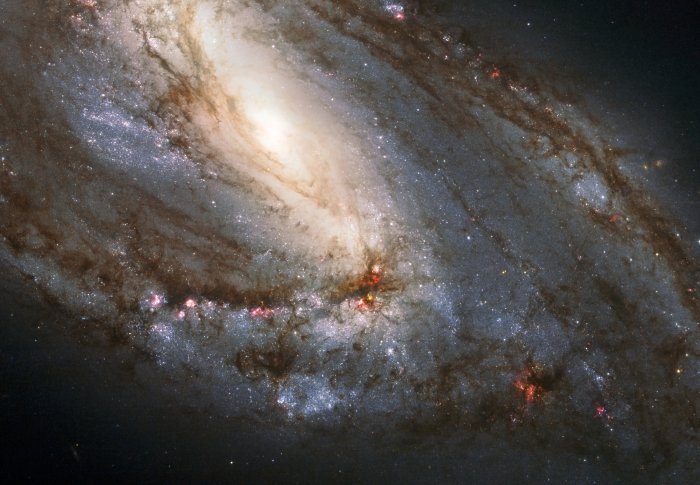March’s Night Sky Notes: Messier Madness
- 02/20/2025
Showing a large portion of M66, this Hubble photo is a composite of images obtained at visible and infrared wavelengths. The images have been combined to represent the real colors of the galaxy. Credit: NASA, ESA and the Hubble Heritage (STScI/AURA)-ESA/Hubble Collaboration; Acknowledgment: Davide De Martin and Robert Gendler
by Kat Troche of the Astronomical Society of the Pacific
What Are Messier Objects?
During the 18th century, astronomer and comet hunter Charles Messier wanted to distinguish the ‘faint fuzzies’ he observed from any potential new comets. As a result, Messier cataloged 110 objects in the night sky, ranging from star clusters to galaxies to nebulae. These items are designated by the letter ‘M’ and a number. For example, the Orion Nebula is Messier 42 or M42, and the Pleiades are Messier 45 or M45. These are among the brightest ‘faint fuzzies’ we can see with modest backyard telescopes and some even with our eyes.
Stargazers can catalog these items on evenings closest to the new moon. Some even go as far as having “Messier Marathons,” setting up their telescopes and binoculars in the darkest skies available to them, from sundown to sunrise, to catch as many as possible. Here are some items to look for this season:

M44 in Cancer and M65 and 66 in Leo can be seen high in the evening sky 60 minutes after sunset. Credit: Stellarium Web
Messier 44 in Cancer: The Beehive Cluster, also known as Praesepe, is an open star cluster in the heart of the Cancer constellation. Use Pollux in Gemini and Regulus in Leo as guide stars. A pair of binoculars is enough to view this and other open star clusters. If you have a telescope handy, pay a visit two of the three galaxies that form the Leo Triplet - M65 and M66. These items can be seen one hour after sunset in dark skies.

Locate M3 and M87 rising in the east after midnight. Credit: Stellarium Web
Messier 3 Canes Venatici: M3 is a globular cluster of 500,000 stars. Through a telescope, this object looks like a fuzzy sparkly ball. You can resolve this cluster in an 8-inch telescope in moderate dark skies. You can find this star cluster by using the star Arcturus in the Boötes constellation as a guide.
Messier 87 in Virgo: Located just outside of Markarian’s Chain, M87 is an elliptical galaxy that can be spotted during the late evening hours. While it is not possible to view the supermassive black hole at the core of this galaxy, you can see M87 and several other Messier-labeled galaxies in the Virgo Cluster using a medium-sized telescope.

Locate M76 and M31 setting in the west, 60 minutes after sunset. Credit: Stellarium Web
Messier 76 in Perseus: For a challenge, spot the Little Dumbbell Nebula, a planetary nebula between the Perseus and Cassiopeia constellations. With an apparent magnitude of 12.0, you will need a large telescope and dark skies. You can find both M76 and the famous Andromeda Galaxy (M31) one hour after sunset, but only for a limited time, as these objects disappear after April. They will reappear in the late-night sky by September.
Plan Ahead
When gearing up for a long stargazing session, there are several things to remember, such as equipment, location, and provisions:
- Do you have enough layers to be outdoors for several hours? You would be surprised how cold it can get when sitting or standing still behind a telescope!
- Are your batteries fully charged? If your telescope runs on power, be sure to charge everything before you leave home and pack any additional batteries for your cell phone. Most people use their mobile devices for astronomy apps, so their batteries may deplete faster. Cold weather can also impact battery life.
- Determine the apparent magnitude of what you are trying to see and the limiting magnitude of your night sky. You can learn more about apparent and limiting magnitudes with our Check Your Sky Quality with Orion article.
- When choosing a location to observe from, select an area you are familiar with and bring some friends! You can also connect with your local astronomy club to see if they are hosting any Messier Marathons. It’s always great to share the stars!
You can see all 110 items and their locations with NASA’s Explore the Night Sky interactive map and the Hubble Messier Catalog, objects that have been imaged by the Hubble Space Telescope.



